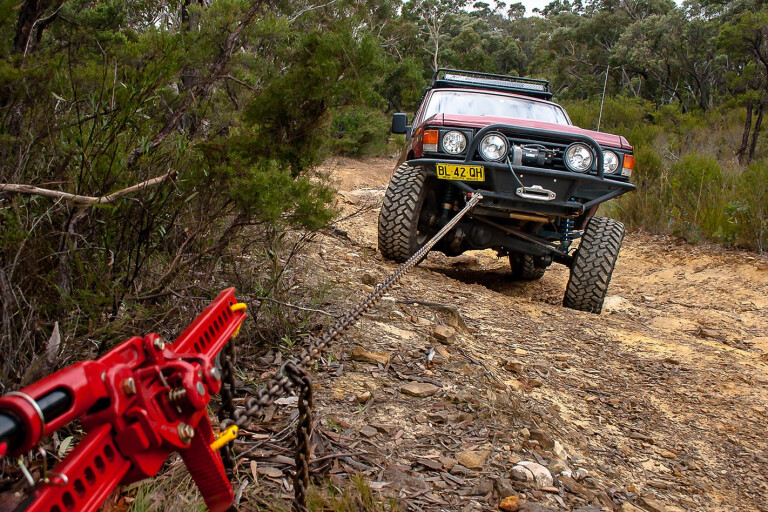
SOME recovery accessories have cutting-edge designs, are easy to use and can dramatically increase safety.
But not the high-lift jack. They’re heavy, almost laughably low-tech, and they have the potential to put a grown man in hospital with a bag full of previously attached teeth.
Despite this, they are without doubt the most versatile piece of recovery equipment you can buy and should have a place in any tourer worth its salt.
The basic design has been around for more than 100 years, with the Bloomfield Manufacturing Company (owner of the Hi-Lift Jack Company) first putting it on the market in 1905 as the Automatic Combination Tool. Over the next century, the number of uses the jack was put to paled only in comparison to how often the design was copied.
Unlike more niche products, the high-lift is so versatile due to its simplicity – in basic form it’s essentially a huge mechanical lever. Using a range of various attachments, tourers can utilise that force and perform a huge range of jobs with the one tool: straighten bent steering rods; press in uni joints; turn a vehicle around on the spot; it can even double as a hand winch.
HOW IT WORKS
IF YOU’VE ever ran your eyes over a high-lift jack, you’d no doubt be familiar with the I-beam spine and the numerous holes throughout. While the holes keep weight down, their main purpose is to provide a stable footing for the jacking mechanism. As the handle cranks back and forth, each cycle unseats one of the two climbing pins from a hole in the spine, before lifting up and sliding into the next hole above.
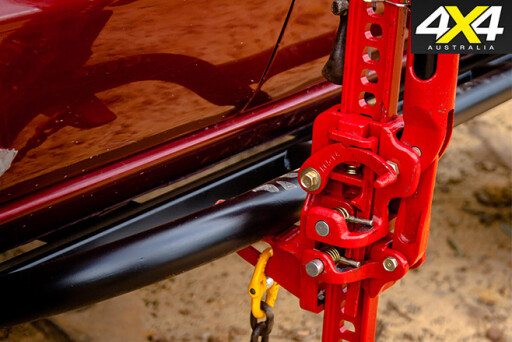 Think of it like walking up a ladder. One foot comes off the rung, moves up to the next, and the next foot follows. All the work is done by the running gear, with the spine acting as a ladder for it to climb. With a long-enough spine, there’s no end to how high you can lift.
Think of it like walking up a ladder. One foot comes off the rung, moves up to the next, and the next foot follows. All the work is done by the running gear, with the spine acting as a ladder for it to climb. With a long-enough spine, there’s no end to how high you can lift.
A high-lift jack will generally have a little over two tonnes of lifting force and is capable of driving in both directions up and down the spine. That said, when cycling down, the jack requires a constant load to work correctly. When the load gets too light, the running gear will drop the rest of the way down the spine.
GETTING IN THE AIR
FIRST and foremost, a high-lift jack is for lifting heavy things like 4x4s, and this is probably the most common reason people buy a high-lift. However, there are a few tricks and techniques to be mindful of before swinging the big red handle like a maniac.
Due to the long suspension travel and high starting height of most 4x4s, lifting directly off the barwork is useless. You’ll still have all four wheels firmly on the ground long after you run out of wheel travel. Higher jacks can overcome this, although there are more elegant solutions.
To lift directly from the wheel, the go-to accessory is known as a Lift-Mate. It’s an adaptor that slides onto the nose of the jack, with two hooks that grab the wheel. If you’re lifting it to clear an obstacle this will get the tyre off the ground; if you’re removing the wheel you’ll need to lower the axle back down onto a wheel-chock before removing the jack. Alternatively, a ratchet strap between the chassis and axle will eliminate suspension droop, allowing you to jack off the vehicle’s barwork.
 That said, in some circumstances the instability can play in your favour. By placing the jack on an angle (in your recovery point or bow-shackle) and cycling the jack into the up position, the 4x4 will not only lift in the air, it will also push it in the direction the jack is leaning. This can be used to get you out of ruts or even just to re-position yourself in off-camber situations.
That said, in some circumstances the instability can play in your favour. By placing the jack on an angle (in your recovery point or bow-shackle) and cycling the jack into the up position, the 4x4 will not only lift in the air, it will also push it in the direction the jack is leaning. This can be used to get you out of ruts or even just to re-position yourself in off-camber situations.
If you find yourself in a dead-end with no room to turn around, a high-lift can be used to turn your vehicle on the spot. Use the same technique as previous to shift the rear end over the length of the jack, and then do the same for the front end in the opposite direction. The process basically involves lifting your 4x4 into the air and repeatedly pushing it off the jack, so it’s definitely a last-resort technique.
HAND-WINCHING
IF YOU’RE a glutton for punishment, you might consider using a high-lift jack as a makeshift recovery winch. Due to the simple nature of the high-lift, the actual process is rather simple. Like any winching operation, you’ll start off by wrapping a tree trunk protector around a suitable anchor point. With a bow-shackle through the ends of the straps, attach it to the top clevis on the high-lift, so you’re winching from the fixed end and not from the moving vehicle.
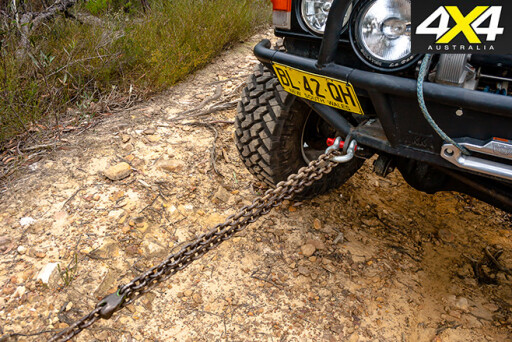 You’ll need a five-metre drag chain to be able to get any sort of usable distance before re-rigging. From here, the actual operation is simple. You’ll have two short chains attached to the high-lift with a hook on the other end – one attached to the spine and the other to the jacking mechanism. Run the drag chain past the jack and grab it with the hook from the jacking mechanism.
You’ll need a five-metre drag chain to be able to get any sort of usable distance before re-rigging. From here, the actual operation is simple. You’ll have two short chains attached to the high-lift with a hook on the other end – one attached to the spine and the other to the jacking mechanism. Run the drag chain past the jack and grab it with the hook from the jacking mechanism.
After engaging the jacking mechanism, cycle the handle to begin pulling the drag chain tight. Once you’re out of travel from the jack, hold the drag chain with the second hook attached to the spine. Then slowly crank the jack backwards, allowing the main chain to take the load so you can re-rig to get the full length of travel again.
It’s a slow and physically demanding job, but if you’re stuck with no other options it can get you out of trouble.
JACK OF ALL TRADES
THEY’RE often bought as a complicated replacement for a bottle jack, but a high-lift should be looked at as a tool that applies massive amounts of directional force. When viewed in that light, they become much more of a do-it-all tool rather than a standalone jack. If you want to lift a wheel off the ground to change a tyre, a bottle jack is a far more appropriate tool. If you need to winch yourself out of mud, lift a tyre out of a bog hole, jack the entire vehicle up to clear a rock, straighten a bent steering rod, or flip a rolled vehicle, the high-lift jack is the go-to piece of kit.
SAFETY FIRST
BEFORE you go racing off to use your high-lift jack as a mobile 4x4 workshop and rescue tool, there are a few key safety aspects to be considered.
Firstly, lifting a large weight a metre in the air in unstable conditions should always be a last resort. The potential for the jack to slip off or out of recovery points shouldn’t be ignored. As a rule, always work on the assumption the vehicle will fall off the jack.
 Secondly, the large arc of the handle applies a massive amount of force into the jack. So, if the jack’s mechanism or the load slips, that force can come back into the handle and turn it into a giant power hammer. Remember to keep two hands on the handle at all times, and keep any bones you don’t want broken out of its way.
Secondly, the large arc of the handle applies a massive amount of force into the jack. So, if the jack’s mechanism or the load slips, that force can come back into the handle and turn it into a giant power hammer. Remember to keep two hands on the handle at all times, and keep any bones you don’t want broken out of its way.
The third and perhaps most often overlooked factor is what will happen when the vehicle becomes unstuck. If you’re winching your 4x4 out of a mud hole and you’re standing downhill when it finally comes un-stuck, your day is about to get a lot worse. If possible, always have someone in the vehicle ready to steer or stop.
7 TIPS FOR USING A HIGH-LIFT JACK
 1. The two chains attached to the high-lift allow the load to be held while the jacking mechanism resets, to allow near-continuous winching.
1. The two chains attached to the high-lift allow the load to be held while the jacking mechanism resets, to allow near-continuous winching.
 2. All jacks of this style should have a lever to reverse the direction. Before flipping it, ensure the load is secure and the jack’s handle is in the upright position with all body parts clear.
2. All jacks of this style should have a lever to reverse the direction. Before flipping it, ensure the load is secure and the jack’s handle is in the upright position with all body parts clear.
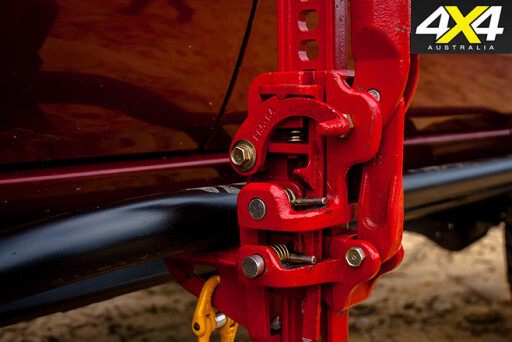 3. Here you can see the jack’s lifting mechanism. As the handle cycles, one pin at a time will pull out and lift up into the next position before locking in.
3. Here you can see the jack’s lifting mechanism. As the handle cycles, one pin at a time will pull out and lift up into the next position before locking in.
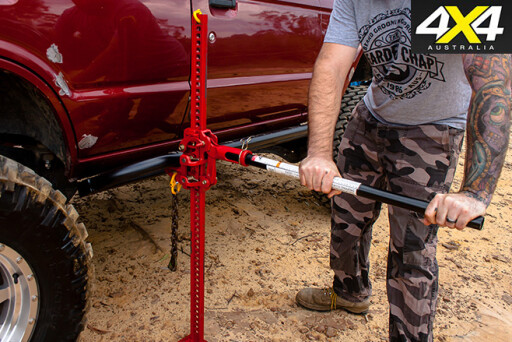 4. When cycling down, the vehicle’s weight will try pushing the handle up. Always use both hands and keep clear.
4. When cycling down, the vehicle’s weight will try pushing the handle up. Always use both hands and keep clear.
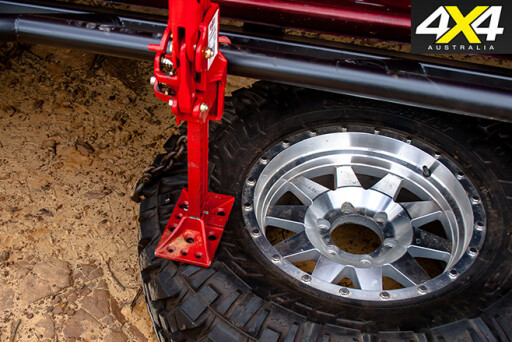 5. By placing the jack’s base against a tyre’s bead and applying pressure, you’re able to break the bead away from the wheel. This can be useful for cleaning the bead or applying internal tyre patches.
5. By placing the jack’s base against a tyre’s bead and applying pressure, you’re able to break the bead away from the wheel. This can be useful for cleaning the bead or applying internal tyre patches.
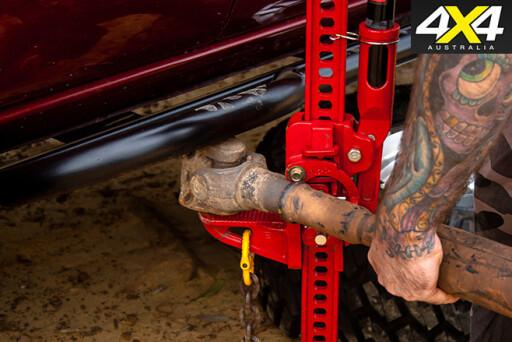 6. With a hard surface and a keen eye, a high-lift jack can be used as a crude press in the field.
6. With a hard surface and a keen eye, a high-lift jack can be used as a crude press in the field.
 7. A set of straps around the chassis and axle can limit suspension droop, allowing you to more easily lift a wheel off the ground.
7. A set of straps around the chassis and axle can limit suspension droop, allowing you to more easily lift a wheel off the ground.
5 TIPS FOR SAFE USE
1. MAINTENANCE
A high-lift jack can become stiff to use (or even jam) due to a build-up of dirt or mud. Store it out of the weather and always give all moving components a spray with silicone lube before use.
2. RECOVERY POINTS
If your barwork has specially designed high-lift jacking points, use them. Jacking off tube or plate steel won’t provide a sturdy connection, increasing the likelihood of the load slipping.
3. USE A BASE
A solid base provides a stable lifting platform. If there’s any doubt the jack might sink into the ground, use a base to spread the load.
4. USE THE RIGHT TOOL
A high-lift jack is designed to move heavy things, not hold them. If you’re working under your 4x4, make sure it’s held with axle stands, or similar.
5. MURPHY'S LAW
If something can go wrong it will. Keep anything you don’t want broken or bruised out of the firing line of the jack handle, the mechanism, and the vehicle’s path to the ground.

COMMENTS